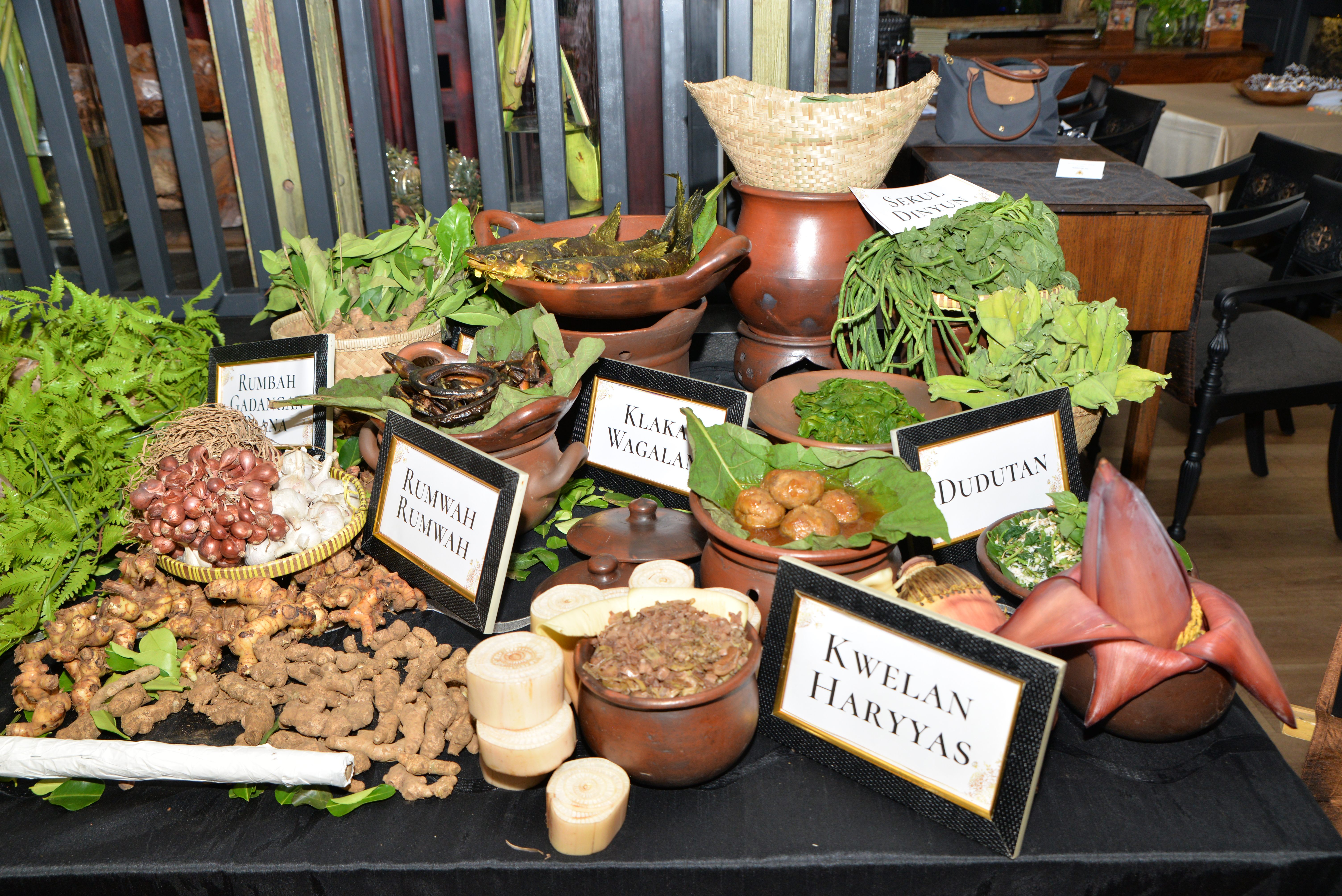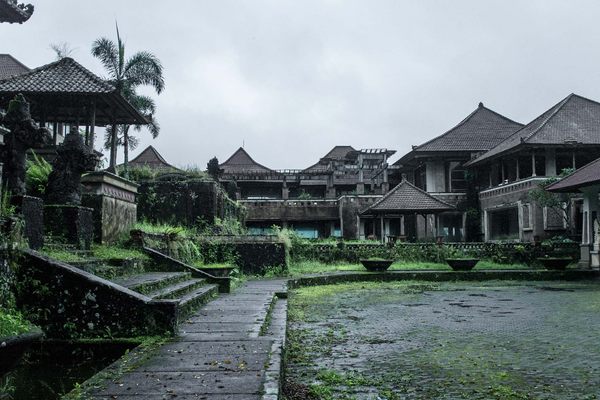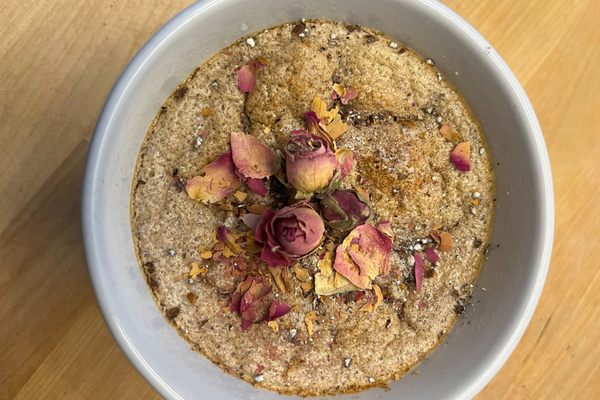How a Dinner Series Brought Borobudur’s Stone Reliefs to Life
The most famous monument in Indonesia shaped these ninth century–inspired feasts.
Often described as the world’s largest Buddhist monument, Borobudur rises from the jungles of central Java: a nine-leveled step pyramid decorated with hundreds of Buddha statues and more than 2,000 carved stone relief panels. Completed in 835 AD by Buddhist monarchs who were repurposing an earlier Hindu structure, Borobudur was erected as “a testament to the greatness of Buddhism and the king who built it,” says religion scholar and Borobudur expert Uday Dokras.
Though Buddhists make up less than one percent of Indonesia’s population today, Borobudur still functions as a holy site of pilgrimage, as well as a popular tourist destination. But for the Indonesian Gastronomy Community (IGC), a nonprofit organization dedicated to preserving and celebrating Indonesian food culture, Borobudur is “not just a temple that people can visit,” says IGC chair Ria Musiawan. The structure’s meticulous relief carvings, which depict scenes of daily life for all levels of ninth-century Javanese society, provide a vital source of information about the people who created it. Borobudur can tell us how the inhabitants of Java’s ancient Mataram kingdom lived, worked, worshiped, and—as the IGC demonstrated in an event series that ended in 2023—ate.

The IGC sees food as a way to unite Indonesians, but the organization also considers international gastrodiplomacy as a part of their mission. Globally, Indonesian food is less well-known than other Southeast Asian cuisines, but the country’s government has recently made efforts to boost its reputation, declaring not one, but five official national dishes in 2018. To promote Indonesian cuisine, the IGC organizes online and in-person events based around both modern and historical Indonesian food. In 2022, they launched an educational series entitled Gastronosia: From Borobudur to the World. The first event in the series was a virtual talk, but subsequent dates included in-person dinners, with a menu inspired by the reliefs of Borobudur and written inscriptions from contemporary Javanese sites.
In collaboration with Indonesia’s Ministry of Foreign Affairs and other partner organizations, the first meal in the Gastronosia series was, fittingly, held at Borobudur, with a small group of guests. The largest event, which hosted 100 guests at the National Museum in Jakarta, aimed to recreate a type of ancient royal feast known as a Mahamangsa in Old Javanese, meaning “the food of kings.” The IGC’s Mahamangsa appeared alongside a multimedia museum exhibition, with video screens depicting the art of ancient Mataram that inspired the menu and displays of historical cooking tools, such as woven baskets for winnowing and steaming rice. Another event, held at Kembang Goela Restaurant, featured more than 50 international ambassadors and diplomats invited by the Ministry of Foreign Affairs.

But how does one translate 1,000-year-old stone carvings into a modern menu that’s not only historically accurate, but appetizing? “We have to have this very wide imagination,” says Musiawan. “You only see the relief [depicting] the food…but you cannot find out how it tastes.” The IGC designed and tested a Gastronosia menu with the help of Chef Sumartoyo of Bale Raos Restaurant in Yogyakarta, and Riris Purbasari, an archaeologist from the Central Java Province Cultural Heritage Preservation Center, who had been researching the food of Borobudur’s reliefs since 2017.
The range of human activities depicted in the reliefs of Borobudur is so wide that it has inspired research in areas of study stretching from music to weaponry. There have even been seaworthy reconstructions based on the “Borobudur Ships” displayed on the site’s lower levels, exquisitely rendered vessels like the ones that facilitated trade in ancient Southeast Asia. So it’s no surprise that Borobudur has no shortage of depictions of food-related scenes, from village agricultural labor, to the splendor of a royal Mahamangsa, to a bustling urban marketplace. Baskets of tropical fruit, nets full of fish, and even some modern Indonesian dishes are recognizable in the reliefs, such as tumpeng, a tall cone of rice surrounded by side dishes, which is still prepared for special occasions. Some images are allegories for Buddhist concepts, providing what Borobudur archaeologist John Mikic called “a visual aid for teaching a gentle philosophy of life.” Uday Dokras suggests that these diverse scenes might have been chosen to help ancient visitors “identify with their own life,” making the monument’s unique religious messaging relatable. The reliefs illustrate ascending levels of enlightenment, so that visitors walk the path of life outlined by the Buddha’s teachings: from a turbulent world ruled by earthly desires at the lowest level, to tranquil nirvana at the summit.

Musiawan says that the IGC research team combined information from Borobudur with inscriptions from other Javanese sites of the same era that referenced royal banquets. While Borobudur’s reliefs show activities like farming, hunting, fishing, and dining, fine details of the food on plates or in baskets can be difficult to make out, especially since the painted plaster that originally covered the stone has long-since faded. Ninth-century court records etched into copper sheets or stone for posterity—some accidentally uncovered by modern construction projects—helped fill in the blanks when it came to what exactly people were eating. These inscriptions describe the royal banquets of ancient Mataram as huge events: One that served as a key inspiration for the IGC featured 57 sacks of rice, six water buffalo, and 100 chickens. There are no known written recipes from the era, but some writings provide enough detail for dishes to be approximated, such as freshwater eel “grilled with sweet spices” or ground buffalo meatballs seasoned with “a touch of sweetness,” in the words of the inscriptions, both of which were served at Gastronosia events.
Sugar appears to have been an important component in ancient Mataram’s royal feasts: A survey of food mentions across Old Javanese royal inscriptions revealed 34 kinds of sweets out of 107 named dishes. Gastronosia’s Mahamangsa ended with dwadal, a sticky palm-sugar toffee known as dodol in modern Indonesian, and an array of tropical fruits native to Java such as jackfruit and durian. Other dishes recreated by the IGC included catfish stewed in coconut milk, stir-fried banana-tree core, and kinca, an ancient alcohol made from fermented tamarind, which was offered alongside juice from the lychee-like toddy palm fruit as an alcohol-free option.

Musiawan describes the hunting of animals such as deer, boar, and water buffalo as an important source of meat in ninth-century Java. Domestic cattle were not eaten, she explains, because the people of ancient Mataram “believed that cows have religious value.” While Gastronosia’s events served wild game and foraged wild greens, rice also featured prominently, a key staple in Mataram that forms the subject of several of Borobudur’s reliefs. It was the mastery of rice cultivation that allowed Mataram to support a large population and become a regional power in ninth-century Southeast Asia. Rice’s importance as a staple crop also led to its inclusion in religious rituals; Dokras explains that in many regions of Asia, rice is still an essential component of the Buddhist temple offerings known as prasad.

The indigenous Southeast Asian ingredients used in Gastronosia’s Mahamangsa included some still widely-popular today, such as coconut, alongside others that have fallen into obscurity, like the water plant genjer or “yellow velvetleaf.” Musiawan acknowledges that modern diners might find some reconstructed ancient dishes “very, very simple” compared to what they’re used to “because of many ingredients we have [now] that weren’t there before.” But in other cases, ninth-century chefs were able to achieve similar flavors to modern Indonesian food by using their own native ingredients. Spiciness is a notable example. Today, chillies are near-ubiquitous in Indonesian cuisine, and Java is especially known for its sambal, a spicy relish-like condiment that combines pounded chillies with shallots, garlic, and other ingredients. But in ancient Mataram, sambal was made with native hot spices, such as several kinds of ginger; andaliman, a dried tree-berry with a mouth-numbing effect like the related Sichuan pepper; and cabya or Javanese long pepper. “It tastes different than the chili now,” Musiawan says of cabya, “but it gives the same hot sensation.” Chillies, introduced in the early modern era by European traders, are still called cabai in Indonesian, a name derived from the native cabya they supplanted.

Gastronosia is just the beginning of IGC’s plans to explore Indonesian food history through interactive events. Next, they intend to do a series on the food of ancient Bali. By delving into the historic roots of dishes Indonesians know and love, the IGC hopes to get both Indonesians and foreigners curious about the country’s history, and dispel preconceptions about what life was like long ago. Musiawan says some guests didn’t expect to enjoy the diet of a ninth-century Javanese noble as much as they did. Before experiencing Gastronosia, she says, “They thought that the food couldn’t be eaten.” But afterward, “They’re glad that, actually, it’s very delicious.”
Gastro Obscura covers the world’s most wondrous food and drink.
Sign up for our email, delivered twice a week.







































Follow us on Twitter to get the latest on the world's hidden wonders.
Like us on Facebook to get the latest on the world's hidden wonders.
Follow us on Twitter Like us on Facebook